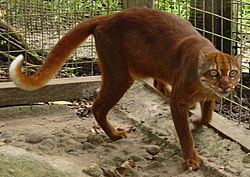| Catopuma | |
|---|---|
 | |
| Bay cat (C. badia) and Asian golden cat (C. temminckii) | |
| Scientific classification | |
| Kingdom: | Animalia |
| Phylum: | Chordata |
| Class: | Mammalia |
| Order: | Carnivora |
| Family: | Felidae |
| Subfamily: | Felinae |
| Genus: | Catopuma Severtzov, 1858 |
| Type species | |
| Felis temminckii [1] | |
| Synonyms | |
Badiofelis Pocock, 1932 | |
Catopuma is a genus of the Felidae containing two small cat species native to Southeast Asia, the Asian golden cat (C. temminckii) and the bay cat (C. badia). [1] Both cats have similar pelage, with solid reddish brown coloration on their backs and darker markings on the head. They also exhibit colour morphs ranging from various browns to gray to black. [2] [3] The Asian golden cat occurs from northeast India to Sumatra, and the bay cat lives only on Borneo. Both inhabit forested areas. [4] [5]
The closest living relative of Catopuma is the marbled cat (Pardofelis marmorata), from which the common ancestor of Catopuma genetically diverged around 9.4 million years ago. [6] The Asian golden cat and bay cat diverged from one another approximately 3.16 million years ago, before Borneo separated from the neighboring islands. [2]



